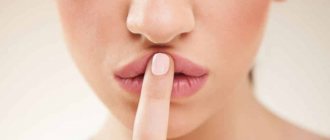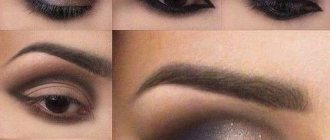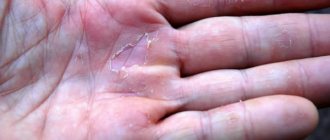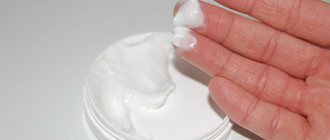What should I do if I have a similar but different question?
If you did not find the information you need among the answers to this question, or your problem is slightly different from the one presented, try asking an additional question to the doctor on the same page, if it is on the topic of the main question. You can also ask a new question, and after a while our doctors will answer it. It's free. You can also search for the information you need in similar questions on this page or through the site search page. We will be very grateful if you recommend us to your friends on social networks.
The 03online medical portal provides medical consultations via correspondence with doctors on the website. Here you get answers from real practitioners in your field. At the moment, on the site you can get a consultation in 45 areas: an allergist, venereologist, gastroenterologist, hematologist, genetics, gynecologist, homeopath, dermatologist, children's gynecologist, children's neurologist, children's surgeon, children's endocrinologist, nutritionist, immunologist, cardiologist, cardiologist, cosmetologist, cosmetologist, cosmetologist speech therapist, ENT specialist, mammologist, medical lawyer, narcologist, neurologist, neurosurgeon, nephrologist, oncologist, urologist, orthopedist-traumatologist, ophthalmologist, pediatrician, plastic surgeon, proctologist, psychiatrist, psychologist, pulmonologist, rheumatologist, sexologist-andrologist , dentist, urologist, pharmacist, herbalist, phlebologist, surgeon, endocrinologist.
We answer 95.55% of questions.
Facial skin is a mirror of all diseases.
Do you know the feeling when you seem to be healthy, but your appearance says otherwise? A tired look, yellowish skin - everything disappears under skillfully applied makeup, and you run to work again, without thinking about the fact that your facial skin is literally screaming at you about some impending (or already existing) illness. Unfortunately, this is exactly what 85% of modern women do. They simply do not have enough time in the daily rush to listen to their body. The “reward” is weeks in a hospital bed and mountains of medications to boot.
By the way, both bags under the eyes and acne can provide a lot of information about the state of our health. Of course, the skin of the face cannot tell you about absolutely all diseases, but it can tell you about many ailments. Everyone knows that it is easier to prevent a disease than to treat it later, so you should not ignore sudden (even minimal) changes in the skin. After all, in order to determine whether you have a tendency to a particular disease, you do not need to be an experienced doctor. Sometimes just looking at yourself in the mirror is enough.
Important: this information can in no way replace a visit to a doctor. This is just a reason to think about your own health and the health of those close to you, balance your diet and switch to a healthy lifestyle.
Thick skin with fairly dense wrinkles that look “puffed up” in the upper part of the forehead indicates weakened kidney function. Brownish spots on the skin near the hair roots are liver problems. Two vertical wrinkles that form above the base of the nose are usually a sign that a person's diet is oversaturated with proteins and animal fats, which overload the liver.
Sparse eyebrows with brittle, short, often falling out hairs are a signal of the need to check the thyroid gland; in this case, its hypofunction is likely. If you naturally have very narrow eyebrows, this may be caused by a lack of estrogen, a female hormone. In the opposite situation, when a woman’s eyebrows can be compared to Brezhnev’s eyebrows, that is, they are just as bushy and wide, this may indicate an excess of testosterone, the male hormone.
Upper eyelid
“Sunken” eyes or a sharp fold between the fixed and moving parts of the upper eyelid are evidence of a decrease in overall tone and lack of energy. “Puffy” eyelids indicate that the heart is not able to cope with the stress, it does not beat hard enough, and as a result, the required amount of blood is not delivered to the kidneys. A sagging, thin fold that runs diagonally from the middle to the corner of the eye indicates a weakening of the heart. Wen and brown spots in this area of the face may be a sign of liver disease.
Lower eyelid
The area under the eyes “speaks” about the condition of the kidneys and bladder. If small swellings form under your eyelids, it is very likely that you have bladder problems. If this swelling is more than one and a half centimeters, this means that kidney function is significantly weakened. Redness near the inner corners of the eyes and up to the base of the nose suggests inflammation of the internal organs or stagnation in the blood circulation. The lower eyelid openly indicates the possible presence of gynecological diseases.
The upper part of the cheeks will help to recognize the development of diseases associated with carbohydrate metabolism. Frequent accompaniments of all such problems are wrinkles and gray, lifeless, toneless facial skin. If similar problems are combined with enlarged pores under the cheekbones, this indicates problems with protein metabolism or even protein intolerance.
Now look at your nose in the mirror. A wrinkle running diagonally across the base of the nose may indicate low thyroid function. If an enlargement of the thyroid gland is observed, then you need to contact an endocrinologist. Looking at the back of the nose, you can determine the type of human nervous system. People with a narrow bridge of the nose easily lose their temper and “explode”. People with a wide bridge of the nose are much more balanced and calm. If small blood vessels are visible on the back of the nose, this may indicate a tendency to high blood pressure. The tip of the nose is a “thread” to the stomach. If after eating the skin on the tip of the nose turns white, it means there is not enough gastric juice in the body. If the tip of the nose turns red, this may indicate the presence of gastritis. The wings of the nose are “indicators” of the state of the respiratory organs. Redness of the wings of the nose on a fairly pale face may indicate inflammation of the bronchi. Thickening of the wings may be a sign of asthma.
Nasolabial folds
A pronounced right nasolabial fold, which goes down to the lips and around the tip of the mouth, encourages you to think about the presence of liver disease. A nasolabial fold of a similar shape, but on the left side, is a reason to think about the pancreas. This may indicate problems with carbohydrate metabolism, which affects blood sugar levels. Straight nasolabial folds descending from the nose to the mouth, without forming a classic trapezoid, indicate weakened cardiac activity. This can be either atherosclerosis or cardiovascular failure. If the nasolabial folds have a rounded shape, then you need to pay attention to the functioning of the intestines - it may have weakened peristalsis. Folds ending at the level of the chin indicate digestive problems and too frequent stress. Of course, almost everyone experiences a nervous shock at least once, but only for some such a lifestyle is not only reflected on the skin of the face, but also in the medical record. So we advise you to be careful, look in the mirror at your nasolabial folds more often and, if possible, lead a more relaxed lifestyle.
Underlip
If you are familiar with the feeling of heaviness in your stomach after eating, pay attention to your lower lip. Small wrinkles may indicate that the intestines are “too lazy” to digest food. Pale areas indicate problems with digestion, dark red spots indicate polyps. Well-defined deep wrinkles indicate an imbalance of water balance. The wrinkles on the right side under the lower lip that the mirror showed you indicate a violation of the blood supply to the liver. A lump or redness in the center under the lower lip is a sign to pay attention to your blood sugar levels.
Chin
The chin area is connected to the genitals. Enlarged pores, blackheads and pimples are a sign of irregular menstrual cycle and possible hormonal and gynecological problems. Wrinkles that rise vertically from the chin to the cheeks indicate that you need to pay attention to the duodenum. If there is a clearly visible wrinkle running towards the center of your chin diagonally from your lower lip, then you may have a genetic predisposition to vein problems. A deep, clearly defined dimple on the chin indicates the need to monitor the spine.
There is another disease that is typical for 90% of the entire population of our country. Our people love to self-medicate. Do you have a headache? Took aspirin. Did not help? There is always a stronger remedy in the first aid kit. And so our people swallow pills, mixtures and powders, without thinking about the fact that a completely harmless headache may indicate not a migraine, but another, more serious illness. And while you try to drown out the pain (symptom), the disease progresses. No, no, we are not at all saying that you should run to the doctor at the slightest headache.
However, if your head has been hurting for a week, your skin has turned an unhealthy yellowish color and your usual remedies don’t help, there is reason to think about it. Moreover, you won’t get a second chance to live your life differently, without mistakes. But the body does not forgive mistakes. And a completely harmless disease can turn into a chronic one and cause a lot of trouble. Therefore, do not forget about the annual examination.
Finally, we would like to advise you to look in the mirror not to see signs of an impending illness, but to correct your makeup or simply smile at your loved one. Be an optimist, believe in miracles, and keep all illnesses aside. However, go to the doctor sometimes. But only to make sure that your body works like a clock.
LiveInternetLiveInternet.
-Search by diary
-Subscription by e-mail
-Statistics
Diseases are written on the face, the skin above the upper lip is white..
Text: Ekaterina Eliseeva based on materials from the book by Vistara G. Gaiduk. “Diagnostics by face” (Vistara H. Haiduk: Gesichtsdiagnose)
Pimples. as well as bags under the eyes. can tell a lot about the state of our health. But a disease is always easier to prevent than to treat. To find out whether you have a tendency to a particular disease, sometimes it’s enough to look carefully in the mirror.
Please note that the information below should in no way serve as an alternative to visiting your doctor. This is just a reason to think about your health and the health of your loved ones, balance your diet and start leading a healthy lifestyle.
Thick skin with dense, as if “puffed up” wrinkles in the upper part of the forehead may indicate weakened kidneys.
Two vertical wrinkles above the base of the nose may be a sign that the person's diet is too high in protein and animal fats, which are overloading the liver.
Sparse eyebrows with short, brittle, falling out hairs can signal that it is necessary to check the thyroid gland; the possibility of its hypofunction cannot be ruled out. If your eyebrows are naturally very narrow, this is most often caused by a lack of the female hormone estrogen.
If, on the contrary, a woman’s eyebrows resemble Leonid Ilyich’s eyebrows - just as wide and bushy, then there is a high probability that the male hormone testosterone is present in excess.
Upper eyelid So-called “sunken” eyes or a sharp fold between the moving and fixed parts of the upper eyelid indicate a decrease in overall tone and lack of energy. Puffy eyelids can be a sign that the heart is not coping with the load and is not beating hard enough to deliver the required amount of blood to the kidneys. A thin, sagging fold running diagonally from the middle of the eye to the corner indicates weakened cardiac activity. Brownish spots and/or wen in this area may be a sign that the liver is not working well.
Lower eyelid The area under the eyes “shows” the condition of the bladder and kidneys. If a slight swelling forms under the eyelid, there is a high probability of problems with the bladder. If the size of this swelling is more than 1.5 centimeters, then most likely the kidneys are not functioning as ideally as we would like. Redness in the area from the inner corners of the eyes to the base of the nose suggests stagnation in the blood circulation or inflammation of the internal organs. It’s easy to “read” from the lower eyelid whether everything is in order in terms of gynecology. As a rule, if there is some kind of problem in the uterus, there is swelling in this area.
Problems with carbohydrate metabolism can be recognized by looking at the lower part of the cheeks: their frequent “companions” are wrinkles and skin that appears gray, lifeless and has lost tone. If similar problems in combination with enlarged pores occur higher up - under the cheekbones, then problems with protein metabolism or even protein intolerance can be assumed.
A diagonal wrinkle running across the base of the nose may be a sign that the thyroid gland is underactive. If the thyroid gland is enlarged, then this is a reason to consult an endocrinologist.
Looking at the bridge of the nose, one can guess what type of nervous system its owner has. People who have a narrow nasal bridge easily “explode” and lose their temper. Those who have it wide are much calmer.
If small blood vessels are visible on the back of the nose, then most likely there is a tendency to high blood pressure.
The tip of the nose is “connected” to the stomach. If the tip of the nose turns white after eating, we are talking about a lack of gastric juice. If the tip of the nose is red, gastritis may be the cause.
The wings of the nose “show” the state of the respiratory organs. Reddened wings may be a sign of inflammation of the bronchi. Thickening (compaction) of the wings may indicate a tendency to asthma.
A pronounced nasolabial fold on the right. A pronounced nasolabial fold on the right side, which first goes straight down to the lips, and then, rounding, goes around the tip of the mouth - this is a reason to take care of your liver.
Straight nasolabial folds If the folds descend from the wings of the nose to the mouth almost straight, without forming a classic trapezoid, it is likely that cardiac activity is somehow weakened. This can be both cardiovascular failure and atherosclerosis.
Rounded nasolabial folds If the shape of the nasolabial folds resembles a smiley face (like this), then you should pay attention to how the intestines work. Its peristalsis may be weakened.
Folds that extend down to the chin Folds that end below average indicate digestive problems and too much stress.
Upper lip A thin white line above your upper lip (as if you just drank milk and have a barely visible mustache) can be a sign that food is not being digested well. And the presence of vertical wrinkles may indicate problems with water balance.
If you regularly experience a feeling of heaviness in your stomach after eating (bloating is the same type of problem), take a closer look at your lower lip. Weak wrinkles on it may indicate that the intestines are “lazy” to digest food, individual pale areas indicate problems with blood circulation, dark red spots indicate the presence of polyps, pronounced, fairly deep wrinkles indicate that the water balance is disturbed.
Wrinkles under the lower lip on the right may indicate that the blood supply to the liver is impaired. Redness or even a lump under the center of the lower lip may indicate that you need to monitor your blood sugar levels.
A yellowish tint to the skin in this area is typical when there are problems with fat metabolism; a purple tint indicates a lack of oxygen; brownish indicates that food is stale and “fermenting” in the intestines; grayish indicates that not all nutrients are absorbed.
This area is associated with the genital area. Enlarged skin pores, pimples and blackheads are a sign of irregular menstrual cycle and possible gynecological and hormonal problems.
The presence of wrinkles rising vertically from the chin to the cheeks indicates that special attention should be paid to the duodenum.
A clearly visible wrinkle that runs diagonally from the lower lip to the center of the chin may be a sign of a genetic predisposition to problems with veins.
A clear, fairly deep dimple on the chin indicates that it is necessary to protect the spine.
The user of the Woman website understands and accepts that he is fully responsible for all materials partially or fully published by him using the Woman service. The user of the Woman website guarantees that the placement of materials submitted by him does not violate the rights of third parties (including, but not limited to copyrights), and does not damage their honor and dignity. The user of the Woman website, by sending materials, is thereby interested in their publication on the site and expresses his consent to their further use by the editors of the Woman website.
Use and reprinting of printed materials from the woman website is possible only with an active link to the resource. The use of photographic materials is permitted only with the written consent of the site administration.
Posting intellectual property objects (photos, videos, literary works, trademarks, etc.) on the woman website is permitted only to persons who have all the necessary rights for such posting.
Certificate of registration of mass media EL No. FS77-65950, issued by the Federal Service for Supervision of Communications, Information Technologies and Mass Communications (Roskomnadzor) on June 10, 2016. 16+
At Doctor Vlad's.
Pigmentation as a symptom
In other cases, pigment spots on the lips and in the perioral area may indicate malfunctions in the body. An experienced doctor will help you determine what exactly is causing the production of large amounts of melanin. If the skin above the upper lip suddenly darkens, the specialist will prescribe a comprehensive examination, which will include the following procedures:
- hormone research;
- liver tests;
- general blood analysis;
- Ultrasound of the liver;
- consultation with an endocrinologist;
- Analysis of urine.
After receiving the results of the examination, the doctor will be able to name the specific pathology that caused this reaction of the body and prescribe adequate treatment. This will help say goodbye to the defect and strengthen the weak points of the body.
I'm flying from Chicago!
How to recognize a disease by the face.
For a practicing doctor, sometimes the diagnosis becomes clear at first glance at the patient. These are the typical symptoms of some diseases.
I remember from college that we were taught to look first of all at the nasolabial triangle of a child. If it is pale bluish, it means that the body does not have enough oxygen. This is due to either respiratory or cardiovascular failure. We need to get examined. Or go straight to the hospital.
Also often characteristic are redness of the eyes (liver, fatigue), yellowing of the eyes (hepatitis), coated tongue (cold, stomach) and so on. But these are not all possible signs.
Here I found an article on the Internet, where similar signs are given in a whole list of as many as 41 positions. I read it carefully myself. Some things are true, some are a little doubtful, but quite possible. It looks like the man was writing seriously.
I have not done in-depth research on all the points, but the list itself is very interesting. At the very least, he can give a direction for examination. Of course, if this person is not feeling well.
It is possible that one of the signs listed below is simply a variant of the norm, a feature of the development of this particular person. For example, I have seen as many rosy-cheeked people as possible who did not suffer from tuberculosis at all. In short, don’t get scared right away and don’t run to the doctor. Just think about it...
I announce the entire list:
- Rapidly fading, sagging skin on the cheekbones and cheeks warns that bladder diseases are possible.
- A swollen chin and neck under the lower jaw are health problems associated with poor kidney function.
- Wrinkled, folded skin on the cheekbones is a sign of diseases of the stomach and pancreas.
- A wrinkle across the chin indicates congestion in the gallbladder, decreased liver function, disease of the bladder or genital organs.
- Thin, parchment-like, dry skin on the cheekbones and cheeks is a sign of poor liver function, or the onset of gastritis.
- Periodic numbness of the chin indicates incipient diseases of the heart and blood vessels.
- An enlarged nose, the appearance of a vascular network on the wings of the nose, loose skin on the nose with a reddish or purple tint are signs of an incipient lung disease or pathology of the large intestine.
- Deep wrinkles from the wings of the nose to the corners of the lips indicate a decrease in functions and pathologies in the organs of the gastrointestinal tract, and problems with digestion.
- If the folds from the wings of the nose go to the chin, then you need to be examined for the presence of stomach ulcers, gastritis with high acidity of gastric juice, colitis, enterocolitis, and duodenal ulcers.
- Wrinkles above the upper lip, running parallel to the border of the lips, horizontally, warn of the onset of gynecological diseases.
- Drooping corners of the lips, wrinkles from the corners of the lips to the chin are a sign of gastritis with zero or low acidity of gastric juice, diseases of the pancreas.
- If the lips and skin around the mouth are covered with many grooves, then this indicates the likelihood of spasms in the large intestine and digestive problems.
- Paleness of the skin around the lips and under the nose warns of diseases of the cardiovascular system, heart failure.
- A bluish tint of the skin between the nose and upper lip is a sign of respiratory failure, asthma, pneumonia, and bronchitis.
- If cracks constantly appear in the corners of the mouth, this indicates vitamin deficiency - a lack of vitamins B, A, E, dysbacteriosis, impaired kidney function, hydronephritis, and impaired water-salt metabolism.
- Wrinkles above the bridge of the nose look like many crosses - this is a sign of spinal diseases, the presence of an intervertebral hernia.
- A transverse wrinkle above the bridge of the nose warns of developing osteochondrosis, scoliosis, and flat feet.
- If there are deep multiple transverse wrinkles on the forehead, this is a sign of migraine.
- A vertical deep wrinkle on the bridge of the nose indicates congestion in the body, a tendency to edema, physical inactivity, and lack of oxygen.
- A deep vertical fold on the bridge of the nose between the eyebrows is a sign of liver dysfunction, liver and gallbladder disease, and dyskinesia.
- If the deep vertical groove on the bridge of the nose is more pronounced on the left side, then this is a signal of a malfunction of the spleen.
- A wrinkle located vertically in the middle of the forehead, from the bridge of the nose to the roots of the hair, signals a dysfunction of the gastrointestinal tract and digestive disorders.
- Swollen lower eyelids and crescent-shaped wrinkles indicate problems associated with poor functioning of the kidneys and bladder.
- Constantly swollen eyelids are a sign of insufficient kidney function.
- Constant swelling of the lower eyelids, especially in the morning, indicates diseases of the cardiovascular system.
- A constant strong blush on the cheeks, limited around the perimeter, indicates serious problems with the lungs, destruction of the alveoli, and tuberculosis.
- Yellow or greenish-gray skin on the face indicates liver disease - hepatitis, cirrhosis.
- A sallow complexion warns of impaired pancreatic function.
- A “waxy” face, a bloodless yellowish color of the skin on the face indicates the possible development of cancer.
- Constant shine of the facial skin indicates hormonal disorders and thyroid diseases.
- Strong pigmentation of the facial skin, if there is no pregnancy, may be a sign of liver dysfunction, or diseases of the ovaries and uterus in women.
- Multiple acne, located mostly on the lower part of the face, near the lips, on the chin, on the neck and chest, indicates serious problems in the endocrine system, diseases of the thyroid gland, liver, and ovaries.
- If acne is located mostly on the forehead, cheeks, and wings of the nose, this is a sign of impaired intestinal function and dysbacteriosis.
- If the skin near the inner corners of the eye is lilac or blue, then you need to urgently examine your kidneys.
- Constantly enlarged pupils of the eyes warn of diseases of the nervous system, neuroses, mental disorders, intoxication, and the use of narcotic drugs.
- Constantly constricted pupils may be a sign of increased intracranial pressure, drug intoxication, drug use, thyroid dysfunction, or meningitis.
- Protruding eyes warn of incipient hyperthyroidism.
- Yellow sclera of the eyes indicates intoxication of the body, hepatitis or liver dysfunction.
- Constant watery eyes may be a sign of a lack of potassium in the body.
- Constant redness of the sclera of the eyes indicates increased intracranial pressure, intraocular pressure, retinal detachment, glaucoma, and chronic fatigue.
- The whites of the eyes are bluish in color and warn of the presence of vitamin deficiency and low hemoglobin.
Diagnosis of diseases by the face is not the main thing, but at home it can detect the first signs of an incipient disease. You should report all alarming signs to your doctor and undergo the examination prescribed by him to rule out serious illnesses. Each of us should know how to identify a person’s illness by looking at his face.
White stripe above the upper lip causes.
Please note that the information below should in no way serve as an alternative to visiting your doctor. This is just a reason to think about your health and the health of your loved ones, balance your diet and start leading a healthy lifestyle.
Thick skin with dense, as if “puffed up” wrinkles in the upper part of the forehead may indicate weakened kidneys.
The likely cause of brownish spots on the skin near the hair roots is liver problems.
Two vertical wrinkles above the base of the nose may be a sign that the person's diet is too high in protein and animal fats, which are overloading the liver.
Sparse eyebrows with short, brittle, falling out hairs can signal that it is necessary to check the thyroid gland; the possibility of its hypofunction cannot be ruled out. If your eyebrows are naturally very narrow, this is most often caused by a lack of the female hormone estrogen.
If, on the contrary, a woman’s eyebrows resemble Leonid Ilyich’s eyebrows - just as wide and bushy, then there is a high probability that the male hormone testosterone is present in excess.
Upper eyelid So-called “sunken” eyes or a sharp fold between the moving and fixed parts of the upper eyelid indicate a decrease in overall tone and lack of energy. Puffy eyelids can be a sign that the heart is not coping with the load and is not beating hard enough to deliver the required amount of blood to the kidneys. A thin, sagging fold running diagonally from the middle of the eye to the corner indicates weakened cardiac activity. Brownish spots and/or wen in this area may be a sign that the liver is not working well.
Lower eyelid The area under the eyes “shows” the condition of the bladder and kidneys. If a slight swelling forms under the eyelid, there is a high probability of problems with the bladder. If the size of this swelling is more than 1.5 centimeters, then most likely the kidneys are not functioning as ideally as we would like. Redness in the area from the inner corners of the eyes to the base of the nose suggests stagnation in the blood circulation or inflammation of the internal organs. It’s easy to “read” from the lower eyelid whether everything is in order in terms of gynecology. As a rule, if there is some kind of problem in the uterus, there is swelling in this area.
Problems with carbohydrate metabolism can be recognized by looking at the lower part of the cheeks: their frequent “companions” are wrinkles and skin that appears gray, lifeless and has lost tone. If similar problems in combination with enlarged pores occur higher up - under the cheekbones, then problems with protein metabolism or even protein intolerance can be assumed.
A diagonal wrinkle running across the base of the nose may be a sign that the thyroid gland is underactive. If the thyroid gland is enlarged, then this is a reason to consult an endocrinologist.
Looking at the bridge of the nose, one can guess what type of nervous system its owner has. People who have a narrow nasal bridge easily “explode” and lose their temper. Those who have it wide are much calmer.
If small blood vessels are visible on the back of the nose, then most likely there is a tendency to high blood pressure.
The tip of the nose is “connected” to the stomach. If the tip of the nose turns white after eating, we are talking about a lack of gastric juice. If the tip of the nose is red, gastritis may be the cause.
The wings of the nose “show” the state of the respiratory organs. Reddened wings may be a sign of inflammation of the bronchi. Thickening (compaction) of the wings may indicate a tendency to asthma.
Causes of the problem
A stripe above the upper lip occurs when there is a disruption in the production and breakdown of melanin in the skin. To eliminate the cause of this phenomenon, it is necessary to contact a dermatologist or cosmetologist as soon as possible. With the initial manifestations of the problem, treatment will occur much faster and more effectively.
Why is the skin around my lips white? The reasons for the appearance of a white patch on or around the lips are:
- treatment with medications that contain hormones, taking oral contraceptives;
- liver diseases, as a result of which various disruptions occur in the production of melanin and in its breakdown;
- disturbances in the functions of the adrenal glands;
- disruptions in the menstrual cycle;
- period of bearing a child;
- pituitary diseases;
- pathologies of the thyroid gland;
- incorrect epilation of the “antennae” area.
A light spot in certain areas indicates unfavorable processes in the body. But not in all cases, experts consider this phenomenon as a pathology. If the problem occurs only in the summer and gradually goes away in the fall, a possible cause is the anatomical feature of the face. In this case, it is necessary to protect your skin from excessive exposure to ultraviolet rays in the summer. To do this, you should use sunscreens with SPF above 30. Apply such products half an hour before going outside.
Nasolabial folds
A pronounced nasolabial fold on the right. A pronounced nasolabial fold on the right side, which first goes straight down to the lips, and then, rounding, goes around the tip of the mouth - this is a reason to take care of your liver.
A pronounced nasolabial fold on the left. A nasolabial fold of the same shape as described above, only on the left side is a reason to pay attention to the pancreas. In this case, we may be talking about problems with carbohydrate metabolism, which, in turn, affects sugar levels.
Straight nasolabial folds If the folds descend from the wings of the nose to the mouth almost straight, without forming a classic trapezoid, it is likely that cardiac activity is somehow weakened. This can be both cardiovascular failure and atherosclerosis.
Rounded nasolabial folds If the shape of the nasolabial folds resembles a smiley face (like this), then you should pay attention to how the intestines work. Its peristalsis may be weakened.
Folds that extend down to the chin Folds that end below average indicate digestive problems and too much stress.
Upper lip A thin white line above your upper lip (as if you just drank milk and have a barely visible mustache) can be a sign that food is not being digested well. And the presence of vertical wrinkles may indicate problems with water balance.
Main reasons
A change in the color of the dermis around the mouth is a clear example of a disruption in the process of melanin production. This is a cosmetic problem that causes enormous discomfort and a lot of complexes in women. Stains cannot be masked with foundation; other, more radical measures are taken to eliminate them. Having noticed the first signs of pigmentation above the level of the upper lip, girls think about how to get rid of it as quickly as possible in order to again feel their own attractiveness. The defect is perfectly amenable to correction, but first it is important to determine the factors that provoked its occurrence.
If pigmented dark spots appear above the upper lip, the reasons are often as follows:
- Addison's disease;
- pathologies of the pituitary gland, leading to increased production of melanin;
- use of hormonal contraception;
- raging hormones during pregnancy;
- abnormalities in the functioning of the thyroid gland;
- Depilation of a delicate area performed inappropriately;
- negative changes in the adrenal glands or liver;
- excessive exposure to ultraviolet light.
A dark, blurry spot above the lip, appearing in the summer and disappearing with the onset of autumn, signals the particular characteristics of the dermis and should not cause concern. In this case, you should only protect your skin from direct sunlight: when going outside, apply a cream with a high level of protection, or wear a wide-brimmed hat. If you take precautions, even in the hot season, your skin tone will be light and even.
Underlip
If you regularly experience a feeling of heaviness in your stomach after eating (bloating is the same type of problem), take a closer look at your lower lip. Weak wrinkles on it may indicate that the intestines are “lazy” to digest food, individual pale areas indicate problems with blood circulation, dark red spots indicate the presence of polyps, pronounced, fairly deep wrinkles indicate that the water balance is disturbed.
Wrinkles under the lower lip on the right may indicate that the blood supply to the liver is impaired. Redness or even a lump under the center of the lower lip may indicate that you need to monitor your blood sugar levels.
The main reasons for the appearance
Areas of darkening above the lips usually cannot be disguised with foundation or compact powder, so for many women this is a real problem. No folk treatment or use of medications will help with this phenomenon; usually the most effective methods are radical removal options. But before removing the dark streak, it is recommended to first consult with a dermatologist, since the cause may be some endogenous factors, and they also need to be eliminated.
With local accumulations of melanin, it can be judged that some disturbances are occurring in the human body. They often appear due to excessive use of artificial tanning or prolonged daily exposure to intense sunlight.
Why do dark areas appear above the lip:
- Dysfunctions in the thyroid gland.
- Excessively frequent visits to the solarium, regular exposure to the sun's rays.
- Dysfunctions in the activity of the adrenal glands, in particular Addison's disease.
- Hormonal changes in the female body during pregnancy.
- Disorders in the menstrual cycle in women.
- Prevention with oral hormonal contraceptives.
- Diseases or pathological processes in the liver.
- Carrying out poor-quality peeling or hair removal.
- Dysfunctions in the pituitary gland, which provoke excessive production of melanin.

Before you do anything to remove stains, you first need to determine the root cause of their appearance. If the cause is disturbances in the functioning of the liver, intestinal tract, kidneys or gall bladder, you should first undergo an appropriate course of treatment. After eliminating the underlying disease, such spots usually go away on their own.
Often the appearance of dark spots above the lip occurs during the period when the sun is active - in summer and spring. Over time, such areas begin to gradually lighten. To prevent their occurrence, it is recommended to protect sensitive skin with sunscreens with increased ultraviolet protection (at least +30). To find out the cause, the dermatologist prescribes examinations for the level of thyroid and adrenal hormones.





![[Photo review] “A Sassy Nation” bodysuit from Black Milk Clothing](https://superlady555.ru/wp-content/uploads/fotoobzor-bodi-a-sassy-nation-ot-black-milk-clothing-330x140.jpg)


